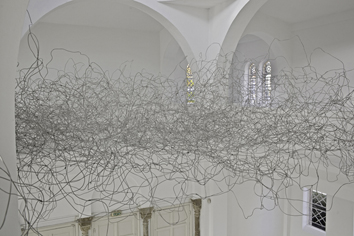
Born in 1923 in Budapest (HG). Died in 2019

2009
Year of Purchase: 2010
“THERE ARE MANY DIFFERENT ANSWERS (AND ALL TRUE) / TO THESE QUESTIONS, / YET NO ANSWER IS NECESSARILY BETTER / THAN THE NEXT, / ALTHOUGH WE LIKE SOME BETTER / BECAUSE THEY FIT MORE NEATLY WITH ANSWERS TO OTHER QUESTIONS / THAT MAY FOLLOW.”
This phrase, which accompanies Yona Friedman’s drawings, has been extracted from his Manual.1 It holds the promise of a very fluid, free, and transmissive thought, as well inspires new ideas in the mind of the reader. Phrases such as this one are like “instruments” supplied by Friedman in order to spark a free flow of singular ideas for “feasible utopias.”2 These phrases are a gateway into the collective, yet composed of singularities, universe of this artist-architect who left a lasting mark on twentieth-century philosophy of architecture through his writings (L’Architecture mobile, 1958; L’Architecture de survie. Une philosophie de la pauvreté, 1974; L’Univers erratique, 1994), through the proliferation of dwellings and structures, his “architecture without buildings,”3 as well as through his experimental models, collages, animated films, and prototypes.
Trained at the Institute of Technology in Budapest until 1943, then at the Technion in Haifa, Israel, Yona Friedman settled in France in 1957 where he founded GEAM (Groupe d’Étude d’Architecture Mobile) aimed at developing—in the context of the exhaustion of natural resources and the urban dead-end identified by Friedman with the great metropolitan centers—new forward-looking, breakthrough social, political, ecological, and architectural concepts. His thought was nourished by his 1970s’ experience of the survival strategies deployed in slums and shantytowns in India, South America, and Africa. Yona Friedman’s philosophy is based on the idea of free will and has been profoundly influenced by the German philosopher Leibniz, namely by his treatise Monadologie (1714) advancing the idea of the individuality of substances and a multitude of changeable states. In his work as architect, Friedman has created concepts (such as self-planning) that subvert traditionally assigned roles and relationships of authority of the architect, the building, and the resident (the future user), as well as provided an iconoclastic example with his Ville spatiale (1959–1960). The architect is no longer the one who designs, constructs, but one who offers advice, techniques, and structures based on which the user can create his or her own environment, his or her own dwelling, and thus the very alternatives for their living space. Similarly, the task of the artist is now only to “provoke” the object; it is the viewer who becomes an artist.
Prototype improvised type “cloud” is one of those curved structures proposed by Yona Friedman, which anyone can build to create their own “cloud” using simple, light-weight, recycled materials… It is an endless cloud, ever changing, always improvised, with the power to transform ambient architectures. Improvisation is Friedman’s liberating key word, and he defines it as a “rapid response to the unexpected and the unknown.”4
Marjorie Micucci
1 Yona Friedman, Manuel volume 3. Introduction by Sylvie Boulanger (Paris-Chatou: Éditions du CNEAI, 2008).
2 Yona Friedman, Architecture Without Building (Paris-Chatou: Éditions du CNEAI, 2012).
3 Yona Friedman, Utopies réalisables (Paris: Union Générale d’Éditions, 1975).
4 Meeting with Yona Friedman and the Chapuisat brothers, Paroles aux artistes/link, November 8, 2013, Centre Pompidou, Paris.